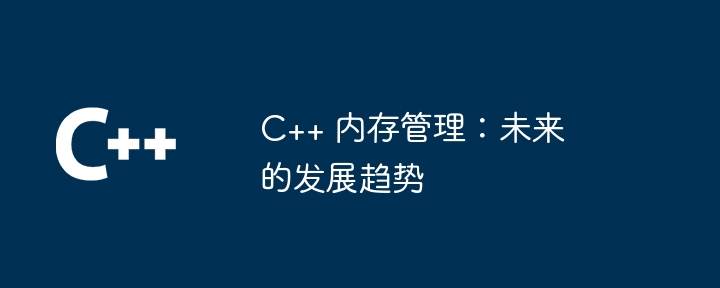
C Memory management is facing three major development trends: The rise of smart pointers helps eliminate pointer errors and improve code robustness and security. The use of memory pools can reduce memory allocation and release overhead and improve application performance. Parallel memory management meets the effective management requirements for memory security in multi-threaded environments.

C Memory Management: Future Development Trends
C Memory management has always been a key aspect in programming languages because it Allows developers to precisely control and manipulate memory. As technology continues to evolve and programming methods change, C memory management continues to evolve to meet the needs of modern applications.
The rise of smart pointers
Smart pointers are one of the most important trends in modern memory management in C. Smart pointers are classes containing pointers that provide automatic memory management capabilities. This helps eliminate pointer errors such as uninitialized pointers and dangling pointers, making your code more robust and safer.
The following code example shows how to use smart pointers:
#include <memory>
int main() {
// 创建一个指向 int 的智能指针
std::unique_ptr<int> ptr = std::make_unique<int>(5);
// 使用智能指针就像使用普通指针一样
*ptr = 10;
// 当智能指针超出作用域时,它会自动释放内存
return 0;
}Use of memory pool
The memory pool is a pre-allocated memory area, used For allocating and releasing objects. By allocating objects in a memory pool, you can reduce the overhead of memory allocation and deallocation, thereby improving application performance.
The following code example shows how to use a memory pool:
#include <boost/pool/pool_alloc.hpp>
int main() {
// 创建一个内存池
boost::pool_allocator<int> pool;
// 从内存池中分配对象
int* ptr = pool.allocate();
// 使用对象
*ptr = 5;
// 释放对象
pool.deallocate(ptr);
return 0;
}Parallel Memory Management
With the rise of multi-core processors and parallel programming, the need for The need for parallel memory management is also growing. Parallel memory management allows applications to safely and efficiently manage memory in a multi-threaded environment.
The following code example shows how to use parallel memory management:
#include <atomic>
#include <thread>
int main() {
// 创建一个原子计数器,用于跟踪分配的对象数
std::atomic<int> counter;
// 创建一个线程数组
std::thread threads[4];
// 启动线程,每个线程分配 100 个对象
for (int i = 0; i < 4; i++) {
threads[i] = std::thread([&counter] {
for (int j = 0; j < 100; j++) {
counter++;
}
});
}
// 等待所有线程完成
for (int i = 0; i < 4; i++) {
threads[i].join();
}
// 打印分配的对象数
std::cout << "Total objects allocated: " << counter << std::endl;
return 0;
}These are just a few of the future trends in C memory management. As languages and programming technologies continue to evolve, we can expect more innovations and practices to optimize memory usage and improve application performance and reliability.
The above is the detailed content of C++ memory management: future trends. For more information, please follow other related articles on the PHP Chinese website!
 What are the differences between c++ and c language
What are the differences between c++ and c language
 Recommended learning order for c++ and python
Recommended learning order for c++ and python
 Cost-effectiveness analysis of learning python and c++
Cost-effectiveness analysis of learning python and c++
 Is c language the same as c++?
Is c language the same as c++?
 Which is better to learn first, c language or c++?
Which is better to learn first, c language or c++?
 The difference and connection between c language and c++
The difference and connection between c language and c++
 C++ software Chinese change tutorial
C++ software Chinese change tutorial
 Cost-effectiveness analysis of learning python, java and c++
Cost-effectiveness analysis of learning python, java and c++




